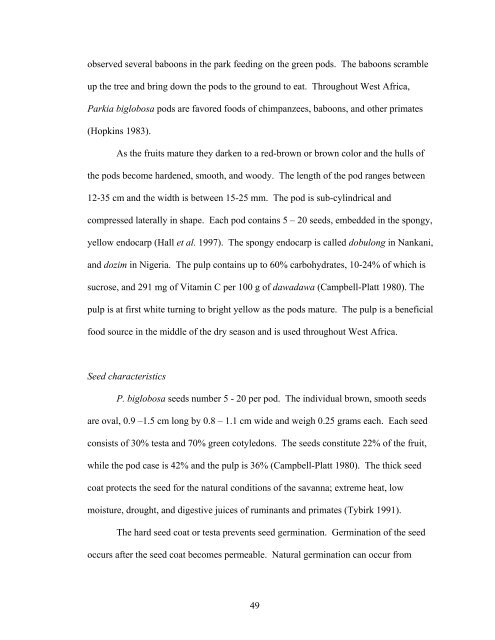i Parkia biglobosa - School of Forest Resources & Environmental ...
i Parkia biglobosa - School of Forest Resources & Environmental ...
i Parkia biglobosa - School of Forest Resources & Environmental ...
Create successful ePaper yourself
Turn your PDF publications into a flip-book with our unique Google optimized e-Paper software.
observed several baboons in the park feeding on the green pods. The baboons scramble<br />
up the tree and bring down the pods to the ground to eat. Throughout West Africa,<br />
<strong>Parkia</strong> <strong>biglobosa</strong> pods are favored foods <strong>of</strong> chimpanzees, baboons, and other primates<br />
(Hopkins 1983).<br />
As the fruits mature they darken to a red-brown or brown color and the hulls <strong>of</strong><br />
the pods become hardened, smooth, and woody. The length <strong>of</strong> the pod ranges between<br />
12-35 cm and the width is between 15-25 mm. The pod is sub-cylindrical and<br />
compressed laterally in shape. Each pod contains 5 – 20 seeds, embedded in the spongy,<br />
yellow endocarp (Hall et al. 1997). The spongy endocarp is called dobulong in Nankani,<br />
and dozim in Nigeria. The pulp contains up to 60% carbohydrates, 10-24% <strong>of</strong> which is<br />
sucrose, and 291 mg <strong>of</strong> Vitamin C per 100 g <strong>of</strong> dawadawa (Campbell-Platt 1980). The<br />
pulp is at first white turning to bright yellow as the pods mature. The pulp is a beneficial<br />
food source in the middle <strong>of</strong> the dry season and is used throughout West Africa.<br />
Seed characteristics<br />
P. <strong>biglobosa</strong> seeds number 5 - 20 per pod. The individual brown, smooth seeds<br />
are oval, 0.9 –1.5 cm long by 0.8 – 1.1 cm wide and weigh 0.25 grams each. Each seed<br />
consists <strong>of</strong> 30% testa and 70% green cotyledons. The seeds constitute 22% <strong>of</strong> the fruit,<br />
while the pod case is 42% and the pulp is 36% (Campbell-Platt 1980). The thick seed<br />
coat protects the seed for the natural conditions <strong>of</strong> the savanna; extreme heat, low<br />
moisture, drought, and digestive juices <strong>of</strong> ruminants and primates (Tybirk 1991).<br />
The hard seed coat or testa prevents seed germination. Germination <strong>of</strong> the seed<br />
occurs after the seed coat becomes permeable. Natural germination can occur from<br />
49








